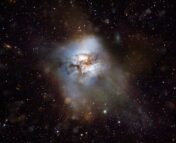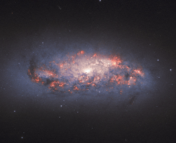Title: The ALMA REBELS Survey: The First Infrared Luminosity Function Measurement at z ∼ 7
Authors: Laia Barrufet, Pascal Oesch, Rychard Bouwens, et al.
First Author’s Institution: Department of Astronomy, University of Geneva, Switzerland
Status: Open access on the arXiv
The details of when and how the first galaxies formed and evolved remain an open question in astronomy. Although we have a basic theoretical understanding of the processes that might have happened, recent observations of galaxies in the early universe have really begun to challenge our conception of early galaxy formation. In particular, observations made with the JWST in the infrared (IR) have revealed a population of massive, luminous galaxies that formed much earlier than expected!
However, much of our understanding of galaxies has been derived from observations of emission by hot, young stars in the ultraviolet (UV)—i.e., we can measure the evolution of the abundance of galaxies in the UV to understand how galaxy populations evolve over time. Today’s authors, and the REBELS (Reionization Era Bright Emission Line Survey) team in general, are aiming to construct a more holistic picture of galaxy populations by extending such observations to longer wavelengths, specifically the IR.
Why IR?
The light from a young stellar population is dominated by the most massive stars, the O and B stars, whose luminosities peak in the UV. Therefore, observing the emission in this wavelength range can be a sensitive tracer of recent star formation. However, stars are born in dusty environments, causing much of the UV light to be scattered and reprocessed by dust grains (read: microscopic particles that interfere with our observations), which will re-emit the light in the mid- to far-IR range. As a result, observations of galaxies in both the UV and IR are strongly correlated with the star-formation rate (SFR; see Figure 1 for example). Consequently, observations of galaxies solely in the UV may likely miss a significant component of the galaxy population that have their starlight obscured and reddened by dust!
Observations of a large number of galaxies in the IR at the highest redshifts have been limited until recently. The REBELS observing program aims to fill this niche by observing high-redshift star-forming galaxies with the Atacama Large Millimeter Array (ALMA), which operates in the far-IR to radio range. Early results from the program have shown that ALMA is capable of detecting some of the most prominent ‘cooling lines’ in the interstellar medium. These lines result from atomic transitions that are easily excited by collisions and thus efficiently radiate away kinetic energy from the gas, such as the [CII] line (singly-ionized carbon). With the REBELS program, the team hopes to deepen the understanding of star formation in these early galaxies.
Motivated by the early success of this program, today’s authors set out to use the REBELS observations to construct an IR luminosity function for galaxies at high redshifts. That is, by measuring the abundance of galaxies per luminosity bin per unit volume for the galaxies observed in the program. The REBELS program collected data from roughly 40 galaxies at z~7 (approx. 700 million years after the Big Bang), selected based on their high UV luminosities (meaning they are likely actively forming stars) and are thus expected to be bright in the IR.
Building the luminosity function
The first step to use REBELS data to construct an IR luminosity function is to measure the total IR luminosity of the galaxies from the individual emission lines. To do so, the authors measure the luminosity of the emission from [CII] lines and use it to estimate the mass of the dust that produces the emission. With this in hand, they are able to calculate the average temperature of the dust distribution and can then infer a total IR luminosity, as dust dominates the emission and has a reasonably well-defined spectral shape.
Building a luminosity function then requires a calculation of the volume over which the observations were made (which effectively comes from the redshift range covered by the REBELS survey) and the fraction of sources in that volume that were observed through REBELS. To do the latter, the authors compare the number of observations they made to the expected number of observations for a survey of their size based on a well-defined UV luminosity function at that same redshift. With the luminosities and volumes, they can then count the number of sources in each luminosity bin and construct the IR luminosity function, shown in Figure 2. This provides the first estimate of the luminosity function at these redshifts!
Today’s authors then take their analysis one step further and use this luminosity function to estimate the star-formation rate density, by adding up the number of galaxies in each luminosity bin and implementing a conversion factor between IR luminosity and star formation rate (i.e., the slope in Figure 1). This estimate is in reasonable agreement with some extrapolations of the star-formation rate density from observations at lower redshifts, and indicates that dust-obscured star formation, as inferred from the IR luminosity function, could contribute at least 10% of the star-formation rate density derived from UV-based estimates.
These results, while limited by the number of galaxies available in REBELS, demonstrate that a significant amount of dust-obscured star formation was already present at very early times in the universe’s history. To extend these results and better constrain the shape of the function, probing the fainter end of the luminosity function with more observations is necessary. Nonetheless, these findings represent an exciting first step towards understanding the prevalence of dusty star formation in the early universe!
Astrobite edited by: Janette Suherli
Featured image credit: adapted from Pixabay and the REBELS program




